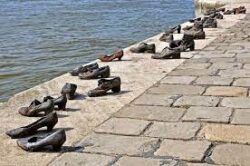Revisiting Evil
Since our Danube cruise, my thoughts keep going back to three Holocaust memorials – and the line between good and evil in people.
In Budapest, we saw the “Shoes on the Danube Bank,” (pictured) a memorial to 20,000 Jews who were rounded up and executed beside the river in 1944-45.
They were ordered to take off their shoes, which were valuable and could be resold. Then they were shot and their bodies dumped into the river – by Hungarians, the militia of the fascist Arrow Cross Party.
We visited the Dohány Street Synagogue, also known as the Great Synagogue, the largest synagogue in Europe. It has a memorial to 400,000 Hungarian Jews murdered by the Nazis.
Near Linz, Austria, I toured Mauthausen concentration camp. It was a rock quarry. Prisoners were forced to carry 100-pound stones up the 186 steps of the Stairs of Death. More than 90,000 died there.
Linz is where Hitler grew up and his anti-Semitism took root. He wanted to reshape it into a grand city that surpassed Vienna, which he hated. Stones from the quarry were to be used for his buildings and monuments.
You can see from the camp how close farms and villages are. The locals knew. They complained about the smell of bodies burning during the day. The Nazis obligingly agreed to operate the crematoria only at night.
I used to wonder how Germans – and, yes, Austrians and Hungarians – could do this. Now I know some people in our country would.
In Downfall: 1939-1945, the second volume of a Hitler biography published in 2020, Volker Ullrich ended with this:
“Hitler will remain a cautionary example for all time. If his life and career teaches us anything, it is how quickly democracy can be prised from its hinges when political institutions fail and civilising forces in society are too weak to combat the lure of authoritarianism; how thin the mantle separating civilisation and barbarism actually is; and what human beings are capable of when the rule of law and ethical norms are suspended and some people are granted unlimited power over the lives of others.”


Revisiting Evil


Since our Danube cruise, my thoughts keep going back to three Holocaust memorials – and the line between good and evil in people.
In Budapest, we saw the “Shoes on the Danube Bank,” (pictured) a memorial to 20,000 Jews who were rounded up and executed beside the river in 1944-45.
They were ordered to take off their shoes, which were valuable and could be resold. Then they were shot and their bodies dumped into the river – by Hungarians, the militia of the fascist Arrow Cross Party.
We visited the Dohány Street Synagogue, also known as the Great Synagogue, the largest synagogue in Europe. It has a memorial to 400,000 Hungarian Jews murdered by the Nazis.
Near Linz, Austria, I toured Mauthausen concentration camp. It was a rock quarry. Prisoners were forced to carry 100-pound stones up the 186 steps of the Stairs of Death. More than 90,000 died there.
Linz is where Hitler grew up and his anti-Semitism took root. He wanted to reshape it into a grand city that surpassed Vienna, which he hated. Stones from the quarry were to be used for his buildings and monuments.
You can see from the camp how close farms and villages are. The locals knew. They complained about the smell of bodies burning during the day. The Nazis obligingly agreed to operate the crematoria only at night.
I used to wonder how Germans – and, yes, Austrians and Hungarians – could do this. Now I know some people in our country would.
In Downfall: 1939-1945, the second volume of a Hitler biography published in 2020, Volker Ullrich ended with this:
“Hitler will remain a cautionary example for all time. If his life and career teaches us anything, it is how quickly democracy can be prised from its hinges when political institutions fail and civilising forces in society are too weak to combat the lure of authoritarianism; how thin the mantle separating civilisation and barbarism actually is; and what human beings are capable of when the rule of law and ethical norms are suspended and some people are granted unlimited power over the lives of others.”